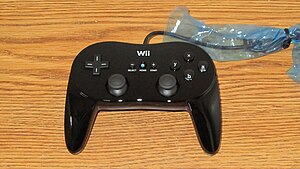Classic Controller Pro

The original Classic Controller
|
|
| Manufacturer | Nintendo |
|---|---|
| Type | Video game controller |
| Generation | Seventh generation |
| Retail availability |
Regular November 19, 2006 Pro August 1, 2009 |
| Input |
|
| Connectivity | Accessory connector plug |
| Predecessor | GameCube controller |
| Successor | Wii U Pro Controller |

A black Classic Controller Pro
|
|
| Manufacturer | Nintendo |
|---|---|
| Type | Video game controller |
| Generation |
Seventh generation era Eighth generation era |
| Connectivity | Accessory connector plug |
The Classic Controller (クラシックコントローラ Kurashikku Kontorōra) is a video game controller produced by Nintendo for the Wii video game console. While it later featured some compatibility with the Wii U console, the controller was ultimately succeeded by the Wii U Pro Controller. As of April 2014, Nintendo had discontinued production of both the Classic Controller and Classic Controller Pro.
When the Wii Remote was first revealed in September 2005, Nintendo had announced a controller "shell" which resembled a traditional game controller, often referred to as a "classic-style expansion controller." As described at the time, the Wii Remote would fit inside the shell, allowing gamers to play games using a traditional-style gamepad, while allowing use of the remote's motion sensing capability. According to Satoru Iwata, it would be meant for playing "the existing games, Virtual Console games, and multi-platform games." Early demos of the Wii's capabilities, showed two players competing in what appears to be Wii Sports with one player using a Classic Controller and another using two Wii Remotes, though this cross functionality was dropped.
During E3 2006, Nintendo introduced the Classic Controller (model number RVL-005), which, rather than housing the remote, instead plugs into it via a cord, in a similar fashion as the Nunchuk. It contains two analog sticks and two extra shoulder buttons: the ZL and ZR buttons, used to replicate the L and R buttons' digital functions found on the GameCube controller. The overall configuration is similar to that of other major seventh generation console gamepads.
...
Wikipedia
